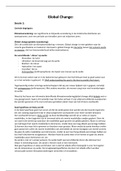Lecture 1. ‘Cultural Materialism: What is Culture?’
The Starting Point
Cultures are never monolithic, they are always tensions, culture is dynamic and full of
contestation:
- Between elite
- Between different global trends and local culture
- Between what is available in the mainstream and what is produced by subcultures
The Aim of the Course
To provide you with a theoretical and analytical toolkit
That will allow you to: Understand and analyze the interaction between culture, politics, and
economics from an international perspective
Culturalism = An anthropological and historically informed understanding of culture, started by
Hoggart, Thompson and Raymond Williams. However, all of them put a different emphasis on
ordinary culture. (p. 49)
Why does culture matter?
- Because it shapes how we think and how we (re)act
- Because today global exchanges and communication are reshaping the outlines of our
culture(s)
- Because studying culture allows you to understand globalization, nationalism, customs,
and rituals of people, communities, and groups
> An example of how culture shapes how we think and act: Personal space: our sense of
personal space is culturally determined but it is very real.
Raymond Williams: Culture: A Contested Concept
What is culture? (Also include above ‘cultures are never monolithic’ in answer)
Answer: A contested concept, it is hard to define.
The conjunction of: Culture:
- “The ideas, customs, and social behaviour of a particular people or society”, and
- ”The arts and other manifestations of human intellectual achievement regarded
collectively.”
→ Culture is “one of two or three most complicated words in the English language”.
As Raymond Williams says:
- Noun: growing crops
- Expanded: cultivating the mind (Bildung)
- Culture as ‘lived experience’ connected to a specific group (19th century) a more
anthropological definition of culture as a whole and distinctive way of life (p. 52)
- Culture is constituted by:
- The meanings generated by ordinary men and women
- The lived experiences of its participants
- The texts and practices engaged by all people as they conduct their lives
→ Culture is what we do, see, feel, think every day
The Cultural Studies Approach
Don’t ask what culture is, ask what it does, how it is used, for what purpose, etc.
,> CS accepts there is not one definition of culture. Tries to understand how culture is used (to
understand meaning, in a dynamic way in society)
→ Culture’s not ‘out there’, its created, performed, enacted, transformed
→ Culture is dynamic, changing, continually contested
Two possible Definitions of Culture
1. High Culture: culture is the best of what a society produces
- Literature
- Fine Arts
- Ballet, classical music, etc.
2. Low/Ordinary Culture: culture is a society’s way of life
- Every day lived experience of a group or community
- Traditions and habits of people
→ Cultural Studies takes this approach (explanation below)
1. High Culture (Culture with a capital C):
- “Culture is a form of “human civilization” that counters the ‘anarchy … of the raw and
uncultivated masses’” (Matthew Arnold)
- “Culture is… “the best that has been thought and said in the world” (Matthew Arnold)
- “Culture is… the high point of civilization” (F.R. Leavis)
- “Culture is… the concern of an educated minority” (F.R. Leavis)
Matthew Arnold (1822-1888): Culture form of “human civilization” that counters the anarchy of
the raw and uncultivated masses. High point of civilisations, best that has been brought and
said in the world. Concern of the educated minority. > In the image below
2. Low/Ordinary Culture (Cultural Studies as a discipline):
CS: Cultural Studies emphasises the importance of ‘ordinary’ culture. It therefore claims to have
a democratic edge as it looks at the lives/interests/culture of the masses not just high/elitist
culture.
It was against the definition of culture as ‘high’ and something that is reserved for a (cultural
and intellectual) elite that Cultural Studies as a discipline struggled, emphasizing time and
again the importance and impact of ‘ordinary’ culture. (More below: ‘Anthropological Approach’)
> Examples: High Culture and Ordinary Culture in Paris: Entrance of the Louvre Museum & Boys
playing soccer in the banlieues (Images below)
,Culture Studies takes the ‘Ordinary Culture’ approach: An Anthropological Approach/Definition
to/of Culture
- Culture is ordinary
→ Meaning: that culture is not limited to high culture (example: art, literature)
but refers to culture as a whole way of life. This includes the social
norms/values/institutions/behaviours.
(p. 46/47)
- Culture belongs to a group of people
- Culture is about everyday meanings: Values (abstract ideas), Norms (definite
principles or rules), and Material/Symbolic goods (p. 47/48)
=> The concept of Culture centres on everyday meanings: values (abstract
ideas), norms (definite principles or rules), and material/symbolic goods. Culture
is understood as a whole way of life thereby this approach distances itself from
the arts and instead focuses on popular and everyday culture.
The focus on the Ordinary Culture we call Culturalism and/or Anthropological approach to
culture:
- The ordinariness of culture
- The everyday lived character of culture
- The active, creative capacity of common people to construct shared meaningful
practices
Why this matter? ‘The Demographic Edge’
- Humanities traditionally study ‘high’ culture in its ‘Arnoldian’ sense (example: as a canon
of the ‘best’ literary and artistic texts available), paying little or no attention to ordinary
culture.
- Cultural studies use a broad, anthropological definition of culture, and studies both elite
and mass culture. It studies the tensions between these two and looks at how ordinary
people give meaning to their lives through culture. This gives it a democratic edge.
Why this Anthropological Approach to Culture in International Studies?
- To understand how other cultures are impacted by globalization you need to study
ordinary, everyday culture.
- To understand the impact of globalization means to learn how culture is intertwined
with politics and economics.
- To understand a particular area or community you can look at ordinary culture.
Cultural Studies: A little more in-depth: Raymond Williams and Cultural Materialism
Raymond Williams 1921-1988 (on Image below): Cultural Materialism (Definition next
page/below)
Raymond Williams wanted to understand how and why cultural meanings and practices are
enacted on a terrain that is not of our making, even as we struggle to creatively shape our lives.
Two Aspects of Culture according to Raymond Williams:
, 1. Known meanings and directions which its members are trained to
2. New observations and meanings which are offred and tested
- (Nature of Culture:) Culture is both: traditional and creative, most ordinary and common
meanings and finest individual meanings
- “A culture has two aspects: the known meanings and directions, which its
members are trained to; the new observations and meanings, which are offered
and tested.”
- “Culture is always both traditional and creative, both the most ordinary common
meanings and the finest individual meanings.”
Use the word ‘culture’ in two senses:
1. Whole way of life (the common meaning)
2. The art and learning (special process of discovery and creative effort
- “We use the word culture in these two senses: to mean a whole way of life. The
common meanings: to mean the arts and learning. The special processes of
discovery and creative effort. I insist on both (senses) and on the significance of
their conjunction.”
Williams introduced the ‘Cultural Materialism’ approach:
Cultural materialism = explores how and why cultural meaning is produced and organized (the
means and conditions of production: both physical and non-physical). It involves the exploration
of signification in the context of the means and conditions of its production. Cultural
materialism is concerned with the connections between cultural practice and political economy.
Unpacking this quote (Marxist influence becomes apparent):
- Means of Production: These are the factors that are at play in producing something (in
our case: cultural meaning). Cultural materialism urges us to ask: What different material
and non-material factors are at work in producing cultural meaning?
- Conditions of Production: The conditions mean how this cultural meaning relates to
other, existing cultural meaning. Cultural materialism urges us to ask: How does a (new)
cultural meaning relate to other, existing cultural meanings in society?
Williams distinguishes Three Levels of Culture: (p. 51)
1. The lived culture of a particular time and place (their ways of living life) (=
Social/Ordinary)
2. The recorded culture, of every kind, from art to the most everyday facts (=
Documentary)
3. The culture of the selective tradition: the factor connecting lived culture and recorded
culture: making selections about what to record and archive and whatnot (what to keep
and what not) (= Ideal)
Why call this ‘Culture Materialism’?
- Culture is part of an expressive totality of social relations:
- You cannot isolate culture from material conditions, economic possibilities, the
social position of who creates this culture
- We can use culture to understand social relations)
- Culture must be understood through the representations and practices of everyday life
in the context of the material conditions of their production
The Starting Point
Cultures are never monolithic, they are always tensions, culture is dynamic and full of
contestation:
- Between elite
- Between different global trends and local culture
- Between what is available in the mainstream and what is produced by subcultures
The Aim of the Course
To provide you with a theoretical and analytical toolkit
That will allow you to: Understand and analyze the interaction between culture, politics, and
economics from an international perspective
Culturalism = An anthropological and historically informed understanding of culture, started by
Hoggart, Thompson and Raymond Williams. However, all of them put a different emphasis on
ordinary culture. (p. 49)
Why does culture matter?
- Because it shapes how we think and how we (re)act
- Because today global exchanges and communication are reshaping the outlines of our
culture(s)
- Because studying culture allows you to understand globalization, nationalism, customs,
and rituals of people, communities, and groups
> An example of how culture shapes how we think and act: Personal space: our sense of
personal space is culturally determined but it is very real.
Raymond Williams: Culture: A Contested Concept
What is culture? (Also include above ‘cultures are never monolithic’ in answer)
Answer: A contested concept, it is hard to define.
The conjunction of: Culture:
- “The ideas, customs, and social behaviour of a particular people or society”, and
- ”The arts and other manifestations of human intellectual achievement regarded
collectively.”
→ Culture is “one of two or three most complicated words in the English language”.
As Raymond Williams says:
- Noun: growing crops
- Expanded: cultivating the mind (Bildung)
- Culture as ‘lived experience’ connected to a specific group (19th century) a more
anthropological definition of culture as a whole and distinctive way of life (p. 52)
- Culture is constituted by:
- The meanings generated by ordinary men and women
- The lived experiences of its participants
- The texts and practices engaged by all people as they conduct their lives
→ Culture is what we do, see, feel, think every day
The Cultural Studies Approach
Don’t ask what culture is, ask what it does, how it is used, for what purpose, etc.
,> CS accepts there is not one definition of culture. Tries to understand how culture is used (to
understand meaning, in a dynamic way in society)
→ Culture’s not ‘out there’, its created, performed, enacted, transformed
→ Culture is dynamic, changing, continually contested
Two possible Definitions of Culture
1. High Culture: culture is the best of what a society produces
- Literature
- Fine Arts
- Ballet, classical music, etc.
2. Low/Ordinary Culture: culture is a society’s way of life
- Every day lived experience of a group or community
- Traditions and habits of people
→ Cultural Studies takes this approach (explanation below)
1. High Culture (Culture with a capital C):
- “Culture is a form of “human civilization” that counters the ‘anarchy … of the raw and
uncultivated masses’” (Matthew Arnold)
- “Culture is… “the best that has been thought and said in the world” (Matthew Arnold)
- “Culture is… the high point of civilization” (F.R. Leavis)
- “Culture is… the concern of an educated minority” (F.R. Leavis)
Matthew Arnold (1822-1888): Culture form of “human civilization” that counters the anarchy of
the raw and uncultivated masses. High point of civilisations, best that has been brought and
said in the world. Concern of the educated minority. > In the image below
2. Low/Ordinary Culture (Cultural Studies as a discipline):
CS: Cultural Studies emphasises the importance of ‘ordinary’ culture. It therefore claims to have
a democratic edge as it looks at the lives/interests/culture of the masses not just high/elitist
culture.
It was against the definition of culture as ‘high’ and something that is reserved for a (cultural
and intellectual) elite that Cultural Studies as a discipline struggled, emphasizing time and
again the importance and impact of ‘ordinary’ culture. (More below: ‘Anthropological Approach’)
> Examples: High Culture and Ordinary Culture in Paris: Entrance of the Louvre Museum & Boys
playing soccer in the banlieues (Images below)
,Culture Studies takes the ‘Ordinary Culture’ approach: An Anthropological Approach/Definition
to/of Culture
- Culture is ordinary
→ Meaning: that culture is not limited to high culture (example: art, literature)
but refers to culture as a whole way of life. This includes the social
norms/values/institutions/behaviours.
(p. 46/47)
- Culture belongs to a group of people
- Culture is about everyday meanings: Values (abstract ideas), Norms (definite
principles or rules), and Material/Symbolic goods (p. 47/48)
=> The concept of Culture centres on everyday meanings: values (abstract
ideas), norms (definite principles or rules), and material/symbolic goods. Culture
is understood as a whole way of life thereby this approach distances itself from
the arts and instead focuses on popular and everyday culture.
The focus on the Ordinary Culture we call Culturalism and/or Anthropological approach to
culture:
- The ordinariness of culture
- The everyday lived character of culture
- The active, creative capacity of common people to construct shared meaningful
practices
Why this matter? ‘The Demographic Edge’
- Humanities traditionally study ‘high’ culture in its ‘Arnoldian’ sense (example: as a canon
of the ‘best’ literary and artistic texts available), paying little or no attention to ordinary
culture.
- Cultural studies use a broad, anthropological definition of culture, and studies both elite
and mass culture. It studies the tensions between these two and looks at how ordinary
people give meaning to their lives through culture. This gives it a democratic edge.
Why this Anthropological Approach to Culture in International Studies?
- To understand how other cultures are impacted by globalization you need to study
ordinary, everyday culture.
- To understand the impact of globalization means to learn how culture is intertwined
with politics and economics.
- To understand a particular area or community you can look at ordinary culture.
Cultural Studies: A little more in-depth: Raymond Williams and Cultural Materialism
Raymond Williams 1921-1988 (on Image below): Cultural Materialism (Definition next
page/below)
Raymond Williams wanted to understand how and why cultural meanings and practices are
enacted on a terrain that is not of our making, even as we struggle to creatively shape our lives.
Two Aspects of Culture according to Raymond Williams:
, 1. Known meanings and directions which its members are trained to
2. New observations and meanings which are offred and tested
- (Nature of Culture:) Culture is both: traditional and creative, most ordinary and common
meanings and finest individual meanings
- “A culture has two aspects: the known meanings and directions, which its
members are trained to; the new observations and meanings, which are offered
and tested.”
- “Culture is always both traditional and creative, both the most ordinary common
meanings and the finest individual meanings.”
Use the word ‘culture’ in two senses:
1. Whole way of life (the common meaning)
2. The art and learning (special process of discovery and creative effort
- “We use the word culture in these two senses: to mean a whole way of life. The
common meanings: to mean the arts and learning. The special processes of
discovery and creative effort. I insist on both (senses) and on the significance of
their conjunction.”
Williams introduced the ‘Cultural Materialism’ approach:
Cultural materialism = explores how and why cultural meaning is produced and organized (the
means and conditions of production: both physical and non-physical). It involves the exploration
of signification in the context of the means and conditions of its production. Cultural
materialism is concerned with the connections between cultural practice and political economy.
Unpacking this quote (Marxist influence becomes apparent):
- Means of Production: These are the factors that are at play in producing something (in
our case: cultural meaning). Cultural materialism urges us to ask: What different material
and non-material factors are at work in producing cultural meaning?
- Conditions of Production: The conditions mean how this cultural meaning relates to
other, existing cultural meaning. Cultural materialism urges us to ask: How does a (new)
cultural meaning relate to other, existing cultural meanings in society?
Williams distinguishes Three Levels of Culture: (p. 51)
1. The lived culture of a particular time and place (their ways of living life) (=
Social/Ordinary)
2. The recorded culture, of every kind, from art to the most everyday facts (=
Documentary)
3. The culture of the selective tradition: the factor connecting lived culture and recorded
culture: making selections about what to record and archive and whatnot (what to keep
and what not) (= Ideal)
Why call this ‘Culture Materialism’?
- Culture is part of an expressive totality of social relations:
- You cannot isolate culture from material conditions, economic possibilities, the
social position of who creates this culture
- We can use culture to understand social relations)
- Culture must be understood through the representations and practices of everyday life
in the context of the material conditions of their production










